Making Masa for Tamales
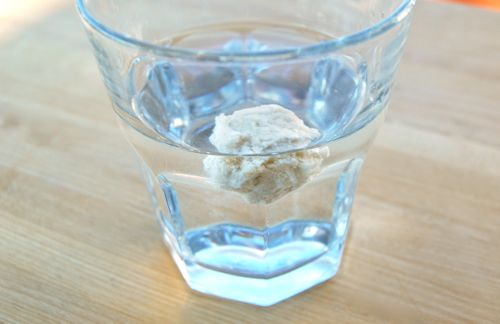
Corn masa for tamales is an easy thing to whip up, especially if you can lay your hands on fresh masa straight from a tortilleria. Failing that some good instant masa is a fine substitute (make sure it says “for tamales” on the package). Here are proportions for both.
1 pound fresh coarse-ground corn masa
4 ounces lard or shortening, chilled
1 teaspoon baking powder
about 6 ounces (3/4 cup) chicken stock
about 2 teaspoons salt
OR
9.25 ounces (1 3/4 cups) instant masa
8.5 ounces (1 cup plus 1 tablespoon) hot water
4 ounces lard or shortening, chilled
1 teaspoon baking powder
about 6 ounces (3/4 cup) chicken stock
about 2 teaspoons salt
The same procedures apply to both for the most part. In the case of instant masa — which I’m using here — you’ll just need to rehydrate it first. Begin by pouring the instant masa into a bowl and adding the hot water:

Stir it until everything seems moist (if not add a little more hot water). If the mixture is putty-like at first, that’s OK. Let it sit until it’s completely cool.
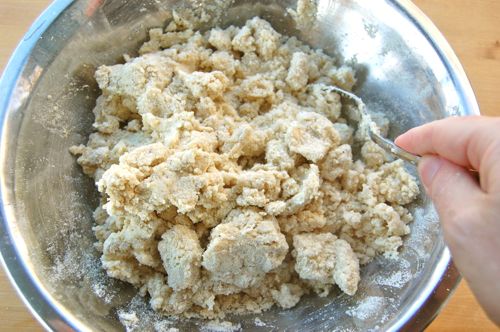
With everything ready, put the lard (or shortening) and baking powder into the bowl of a mixer fitted with the paddle (beater).
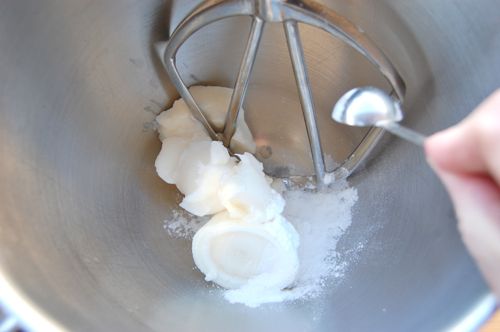
Beat on medium-high until the fat is light and fluffy.

Now add the corn masa (fresh or reconstituted), about a third at a time, beating on medium speed. As the mixture gets more pliable you can increase the speed.
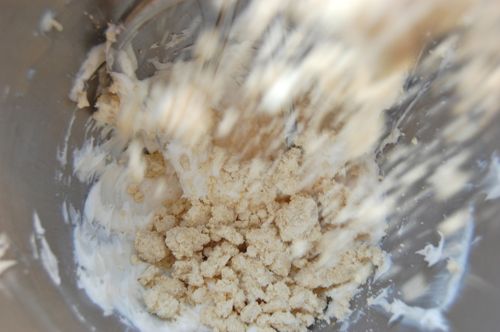
You should have a semi-pliable putty, which isn’t light enough. Not yet. Add about half the chicken stock and…beat it. Here I should insert that you want a nice, light chicken stock for this, not a thick or concentrated one. Mexican cooking — as opposed to say, French — is based on very light stocks. So dilute it until it’s a nice, thin broth of the kind you might use for a refreshing summer tortilla soup.
Good tamal masa is light in every way: light textured, light tasting, and with just enough lard to make it rich without being heavy. But I digress…
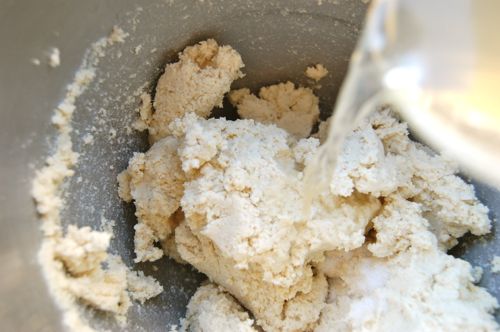
Beat the mixture until it’s as fluffy as, oh say, a frosting or buttercream…adding a teaspoon or more of the salt as you go.

How to tell when it’s ready? Take a pinch of it and drop it into a glass of cool water. If the masa quickly bobs to the surface, you’re ready to rock n’ roll.

If not, you’ve got more beating to do. If the mixture needs more stock or water, add it. When you think you’re ready, taste it. Scrape the bowl and beat in additional salt until it’s just barely seasoned enough. Don’t worry, you can’t over-beat this mixture…which is not to say you should try.
Use the masa right away. Or, if you want to store it in the refrigerator for a few hours, you can. You’ll need to re-beat it with some extra water when it comes time for tamal making. That’s the down side. The up side is the masa will be even lighter and lovelier for the effort.
Would it benefit from resting in the fridge after the hot water before mixing the rest of the ingredients and the beating? I’m just thinking how much nicer whole wheat is after an overnight soak.
When I’ve made tamales, getting cold dough to spread was a nightmare. It went easier with using hot broth, and then it was warm when it was mixed up… but then I didn’t reconstitute it first (duh!), we just used hot chicken stock. It was just the way I was shown… I’m so excited to have your recipe!
Half an hour or so is plenty for instant masa, but I like that instinct! That same brew of starches and enzymes doesn’t exist in corn masa, so a long rest doesn’t really improve it.
Thanks for the question!
– Joe
what about in far flung places where you get neither shortening nor lard?
Hello Ameya!
Butter isn’t traditional but it certainly works. The dough is a bit heavier but the flavor is excellent!
– Joe
ah god bless. now all i need to do is find a nice man in the market-that-has-everything who understands the term wood ash and get me some masa harina…
Butter is used in areas of Veracruz state. Usually only on special feast days, butter is whipped into the masa. Banana leaves are used for wrapping.
Very nice Christopher. Thanks for that!
– Joe
Well done!
Thank you, Sandra. That means a lot to me.
– Joe
How many tamales does this recipe make?
That’s a good question, Bre!
It depends on how big you make them, but I got about sixteen.
– Joe
Joe,
I am currently making bread full time at a restaurant here in Chicago, and stumbled upon your website trying to find information on laminated doughs.
Then I stumbled upon this recipe and I’m going to make tamales tonight!
I have some golden chicken fat leftover from the prep cooks making chicken jus at the restaurant, and I was wondering if this can be substituted for lard?
Also, have you ever laminated dough with chicken fat or another animal fat? I know that butter is around 80% fat and 20% water/milk solids… so perhaps I can weight out the chicken fat, and whip in some water to create the same texture/hydration?
Any ideas or suggestions?
Thank you so much! PS I plan on trying your Kouign Amann recipe within the next week!
Hey Aaron!
Sorry this is late. I would say that chicken fat is a little too liquid to use in either application by itself, but a blend should work out quite nicely. Try a third chicken fat for starters and see what you think!
And get back to me with the results please. Chicken laminated dough…inspired!
– Joe
Your recipe is amazing! Thank you!
My pleasure, Diana!
– Joe
I have just put my tamales in the steamer. I used your masa recipe, using the fresh masa, and I think I like this recipe. I can’t wait to taste them! I’ll let ya know how it goes!
Please do, Deanne! I’ll want to know!
– Joe
How long do you really need to mix? I mixed for a good 10 min and it’s not floating.did I add too much liquid?
Hey Suzann! Whipping incorporates air, which is what makes it float. So keep it up for a while longer. If it’s still not floating, add a little more masa and try the float test again.
Best of luck!
– Joe
Can you add heated lard to dry masa mix first and after mixing thoroughly, add the water?
Hey Jim!
You can do that, but you won’t have the light texture that the whipped shortening gives you. I recommend the whip! 😉
Cheers,
– Joe
Joe, what spices do you put into the masa? No chile?
I don’t but I’m willing to try it! Do you add some in?
– Joe
I just made my first batch of masa, I ran out of the prepared masa from the store…so I put salt, baking powder and maseca water and lard. but I used a whole package of maseca, the 4.4 pound size and I used two pounds of lard…the consistency is ok, but I think I used too much lard looking at your recipe above…will they be ok?or do I need to go to the store and get more maseca?
I don’t think there’s ever such a thing as too much lard, Lydia. 😉
My suggestion is to try it out and see. You can always add more masa later if you’re not happy with the end product. Let me know how they go!
– J
If I wanted to use butter in my masa,do I use salted or unsalted?ive seen a few that say unsalted but wasn’t sure?thanks much
Hello Sasha!
Salted or unsalted won’t matter much in this sort of application. You can do either.
Let me know how they go!
– Joe
Would you ever consider making a video for this? I have about two weeks to learn how to make masa for my grandparents. They are feeling nostalgic and want to have tamales like the ones they used to eat in Mississippi in the 50’s. I need to impress and I learn better when watching an example…can you help? PLEASE! 🙁
Hey Simone!
I don’t do videos but if you follow along with the pictures you won’t get into trouble I promise. And I love Mississippi tamales. I had some in Natchez a few years ago that were to die for.
Cheers and good luck!
– Joe